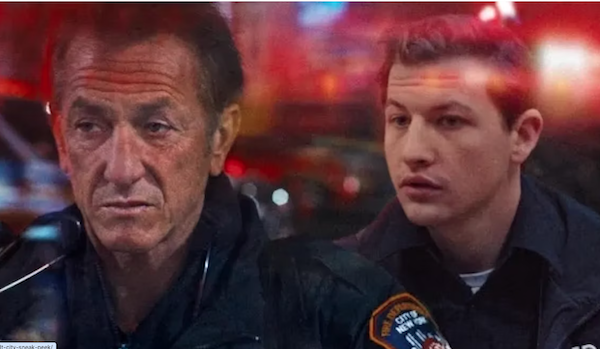Film Review: “Asphalt City” — Paramedics on the Mean Streets
By Tim Jackson
The director did his research: he rode with EMTs so the Asphalt City’s grim vision is real and convincingly ramped up.
Asphalt City, directed by Jean-Stéphane Sauvaire. Screening at AMC and Showcase Cinemas.

Sean Penn and Tye Sheridan in a scene from Asphalt City.
A keen stylist of grit and pulp, French director Jean-Stéphane Sauvaire was a suitable choice to helm a film adaptation of Shannon Burke’s 2008 noir novel Black Flies, retitled Asphalt City. This new effort looks similar to the director’s 2008 movie Johnny Mad Dog, which followed the evolution of a child soldier in Liberia as he was groomed for war. Sauvaire’s verité approach drew viewers into the hallucinatory madness of a world in which violence and brutality had become pleasurable, intoxicating. Asphalt City chronicles the plight of a pair of night shift EMTs, played by Sean Penn and Tye Sheridan, as they cruise the Brooklyn neighborhoods of East New York and Brownsville. The pair are pulled into an endless succession of lurid and blood-soaked medical emergencies. It is soul-killing work; this is a grim vision of the city at its scuzziest.
A resident of Brooklyn himself, Sauvaire immerses the viewer in a harsh reality, ostensibly to frame the heroic sacrifice of its protagonist health care workers. Each evening, the EMTs cut away bloody clothing, jab lifesaving adrenaline needles, and apply defibrillators. Ironically, they often have to fend off ungrateful or aggressive onlookers along with the hysterical families of the underclass population that they serve: immigrants, addicts, the mentally ill, and the homeless. Ambulances careen from one crisis to the next. Sirens blare amidst the unrelenting clamor raised by grubby neighborhoods. The chaos of Brooklyn streets flies by via rapid point-of-view shots as the medicos race down city streets. The director did his research: he rode with EMTs, so the film’s proceedings are real and convincingly ramped up.
This visceral shooting style is grounded in solid performances. Sean Penn is Gene Rutkovsky, who goes by the nickname “Rut.” He’s a veteran technician partnered with medical student Ollie Cross, played by Tye Sheridan. The plot is familiar: a world-weary pro is coaching a relative greenhorn. Cross rents a crowded tenement apartment to save money for medical school; we sense the stoic persistence behind his eyes, but there is little respite from the job’s daily anarchy. The blatant symbolism of the names — Rut and Cross — are assurances that epiphanies and sacrifice will be served. Meanwhile, the pair address one crisis after another, pausing briefly for fast food before rushing to the next incident. It is essentially a road movie that, given the craziness of the streets, comes off as a bit pat. The problem is that viewers will long for some relief, a ray of hope amidst endless turmoil, but a tidy conclusion risks feeling unsatisfyingly obligatory. Meanwhile, as we all know, the streets roil on.
Penn’s aging face is a map of angst and endurance. The two-time Oscar winner (nominated three additional times) takes charge of every scene. He is especially effective at repressing his character’s emotions. Behind Rut’s bluster, the frustration of being both an angel of mercy and merchant of death, of having to control crowds and save lives, is physically and psychologically exhausting. The pair are neither cops or doctors — yet their work demands elements of both professions. Ultimately, the stress undercuts their personal relationships. Katherine Waterston makes a brief appearance as Rut’s weary ex-wife. Raquel Nave is Cross’s fed-up girlfriend, Clara. As the jaded and cynical driver Lafontaine, Michael Pitt harbors few reservations about decisions regarding who does and does not deserve resuscitation.
Other performers include Mike Tyson, who makes a forceful appearance as Chief Burroughs. Late in the film, there is a pivotal turn by Kali Reis as a drug-addicted mother giving birth to what may or may not be a stillborn child. This is a critical moment in the story — harrowing and graphic. Reis, a professional boxer, brings to the role the steel she showed as Angel Navarro in the fourth season of True Detective.
Asphalt City‘s strength is that it matches style with substance. Also, a menagerie of amateur performers infuse the film with an astonishing authenticity. In Johnny Mad Dog, Sauvaire workshopped with young actors so they could safely (but convincingly) perform acts that were perilously close to what they experienced in their real lives. A similar dynamic is at play here. Actors rehearsed and developed their scenes, resulting in moments when the line between fiction and fact becomes indistinguishable.
Tim Jackson was an assistant professor of Digital Film and Video for 20 years. His music career in Boston began in the 1970s and includes some 20 groups, recordings, national and international tours, and contributions to film soundtracks. He studied theater and English as an undergraduate, and has also worked helter skelter as an actor and member of SAG and AFTRA since the 1980s. He has directed three feature documentaries: Chaos and Order: Making American Theater about the American Repertory Theater; Radical Jesters, which profiles the practices of 11 interventionist artists and agit-prop performance groups; When Things Go Wrong: The Robin Lane Story. And two short films: Joan Walsh Anglund: Life in Story and Poem and The American Gurner. He is a member of the Boston Society of Film Critics. You can read more of his work on his blog.
Tagged: Asphalt City, EMTs, Jean-Stéphane Sauvaire, Sean Penn, paramedics

